SOS: What Are Modes?
 The international Morse Code distress signal (SOS) is three short "dits" followed by three longer "dahs," follow by three short "dits."
The international Morse Code distress signal (SOS) is three short "dits" followed by three longer "dahs," follow by three short "dits."

If we move the first three dits to the right side, the Morse code signal would look and sound totally different.
![]()
Scales are like Morse code. They consist of half-step intervals (1 fret or dits) and whole-step intervals (2 frets or dahs). The major scale intervals would look this in Morse code:
![]()
Say it quickly: dah dah dit dah dah dah dit
If we move the first interval of the major scale to the right side, we get a different looking and sounding scale. This scale is called the Dorian mode.
![]()
Say it quickly: dah dit dah dah dah dit dah
Modes are just the intervals of the major scale arranged in a different order. Like Morse code, if you rearrange the intervals you get a different sound.
Modes Have Moods
Modes add flavor to our songs. The minor scale is a mode. If we eliminated it, we'd be left with the happy sounding major scale. Songs like Yesterday, Hallelujah, The House of the Rising Sun or Stairway to Heaven would suddenly be happy sounding songs. So modes are a good thing.
You already know two of the seven modes. One mode is the major scale (Take a bow!) and the other is the minor scale. The major scale has five other modes. They each have a different flavor. You might say modes have moods:
1. Ionian (major scale) - "happy"
2. Dorian - "sad but hopeful"
3. Phrygian - "dark and tense"
4. Lydian - "mystical"
5. Mixolydian - "bluesy"
6. Aeolian (minor scale) - "sad"
7. Locrian - "dark"
Modes also have Greek names. The major scale is called Ionian and the minor scale is called Aeolian. The chart below shows the starting interval for each mode. The small boxes are the half step intervals, and the wider boxes are the whole steps.
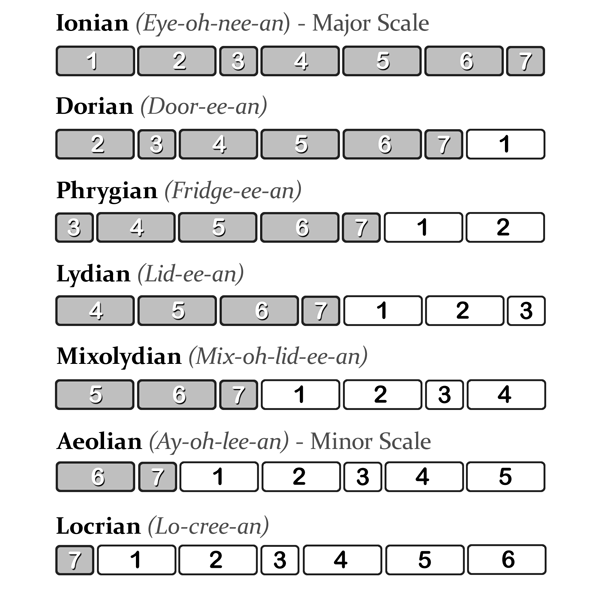
At this point, we can expand our definition of modes:
- Modes are scales
- Modes have moods
- Modes use the intervals of the major scale
- Modes have unique arrangements of those intervals
- Modes can be major or minor sounding
- Modes have relative modes
And here are modes with their relative modes.
- Ionian and Aeolian
- Mixolydian and Phrygian
- Lydian and Dorian
That leaves the Locrian mode. The Locrian mode does not work with Freedom Blocks. It does have a minor 3rd which makes it a minor scale, but it also has a flat 2nd and a flat 5th. Altogether it has a dissonant sound, sometimes called the "devil in music".
If you're curious, try playing this next A Locrian pentatonic scale. I find it interesting, but I'm not sure why.
(Notation: E5-8, A5-6, D5-7, G5-7-8, B8, E5-8)
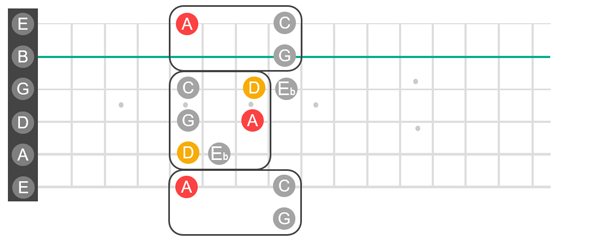
Now that you had an introduction to modes, let's see how easy it is to switch from a pentatonic scale into any of the remaining four modes.
Lydian and Dorian Modes
Lydian is a major scale and Dorian is a minor scale. The green notes are in the same position for both modes because they are relative scales.

TIP: the extra notes are on the right side of the rectangles, so they'll be on the left side of the squares. Do you know why green notes are never next to orange notes? (Answer: rEcTanGles nEvEer oVerLap oRanGe nOtes.)

Starting out you can look at this from two perspectives: one being a square and the other being a rectangle.

Here is a C Lydian scale with its major 3rd.
(Notation: E5-7-8, A5-7, D4-5-7, G4-5-7, B5-7-8, E5-7-8)
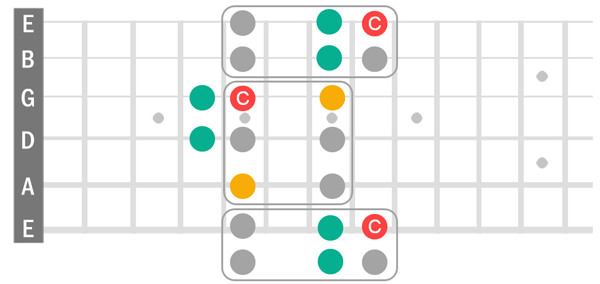
Here is an A Dorian scale with its minor 3rd.
(Notation: E5-7-8, A5-7, D4-5-7, G4-5-7, B5-7-8, E5-7-8)
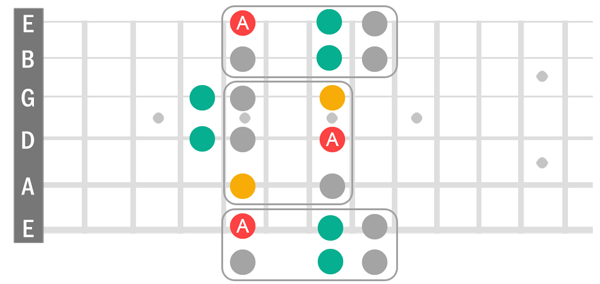
The Lydian and Dorian patterns look very similar. That's because A Dorian is the relative minor of C Lydian. Just like A Aeolian (the minor scale) is the relative minor of C Ionian (the major scale).
Mixolydian and Phrygian
Mixolydian is a major scale and Phrygian is a minor scale. The two extra green notes are in the same position for both modes.

TIP: the extra notes are on the left side of the rectangle, so they'll be on the right side of the squares.

Again it might be helpful to look at this from two perspectives: one being a square and other a rectangle.

Here is a C Mixolydian scale.
(Notation: E5-6-8, A5-7-8, D5-7-8, G5-7, B5-6-8, E5-6-8)
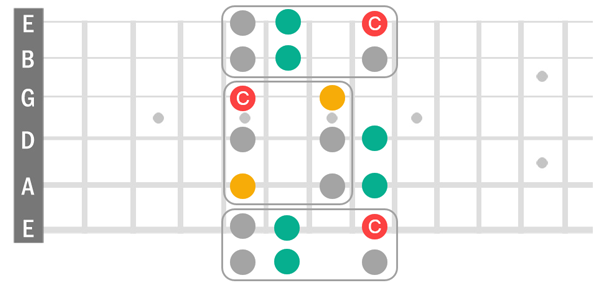
Here is an A Phrygian scale. Once again the scale patterns are similar. A Phrygian is the relative minor of C Mixolydian. They share the same notes, but emphasize different root notes.
(Notation: E5-6-8, A5-7-8, D5-7-8, G5-7, B5-6-8, E5-6-8)
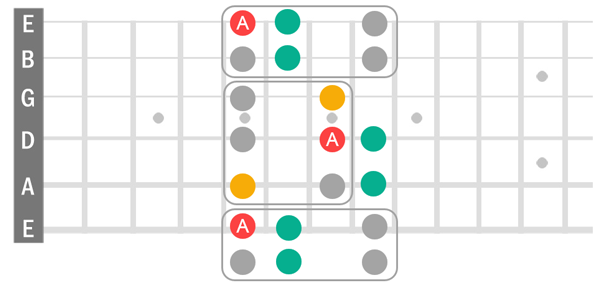
Here is a simplified view of what we've just covered. I've used uppercase letters for major scales roots and lowercase letters for minor scale roots.

Using Freedom Blocks you can move in any direction, and the two green notes will follow along. You can instantly switch between diatonic and pentatonic scales, or switch to a different mode of a major scale.
To hear the difference between modes, watch this YouTube video by Jake Lizzio or Google: Jake Lizzio demonstrates all 7 modes.
Mode Names and How to Remember Them
Each of the seven modes have Greek names. Most discussion of modes use the Greek names, so you'll want to learn them. Here are memory cues to help you remember the names.
- Ionian "I own"
- Dorian" door"
- Phrygian "fridge"
- Lydian "lid"
- Mixolydian "mix"
- Aeolian "a hole"
- Locrian "low cream"
Notice that all of the names end in the sound "ee-an."
Now create a story in your mind using these memory cues.
- I own a home
- It has a door
- When I'm hungry I go straight to the frig...
- I take the lid off the ice milk
- I mix in chocolate syrup
- There's a hole in the syrup bottle (what a mess)
- The ice milk has low cream